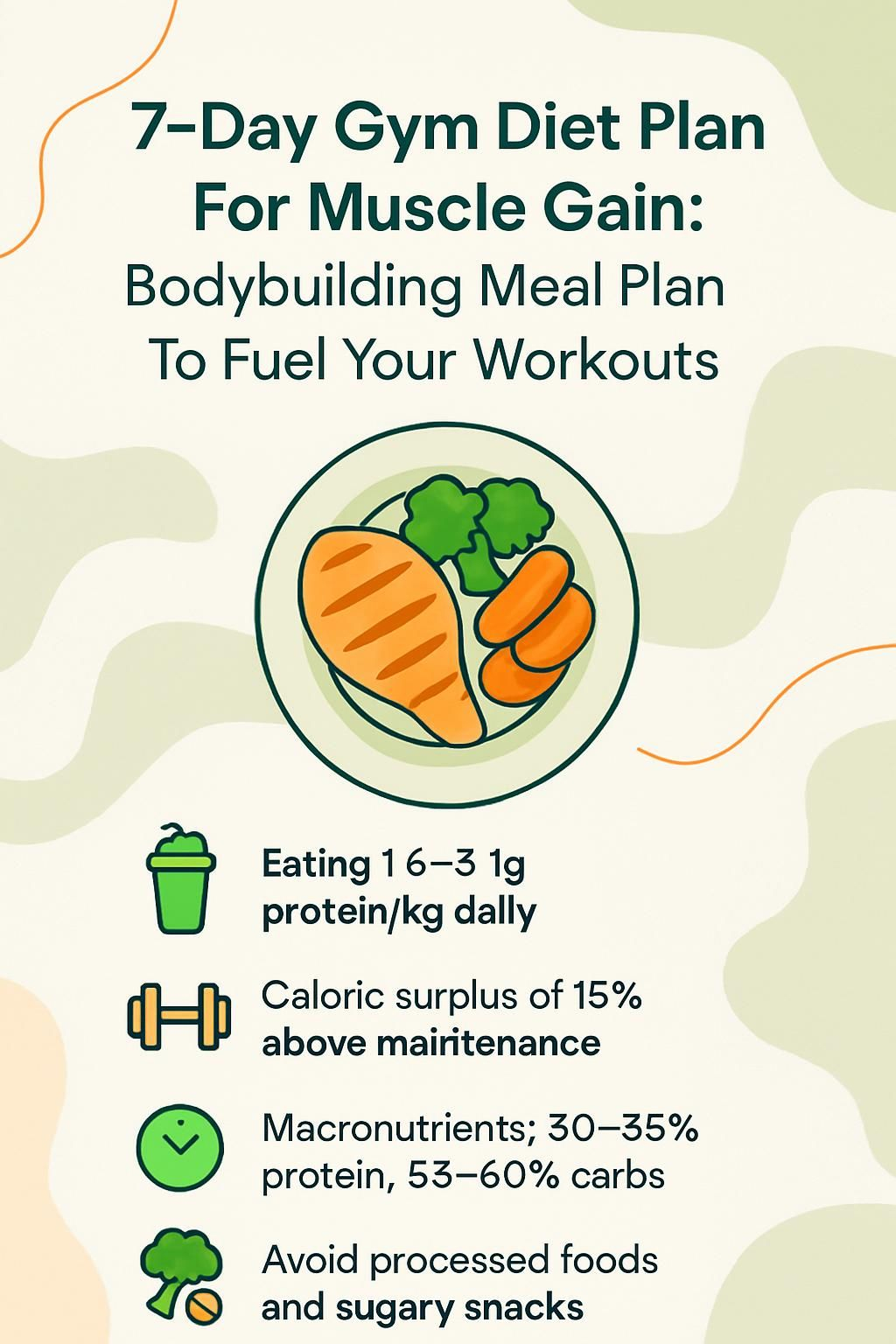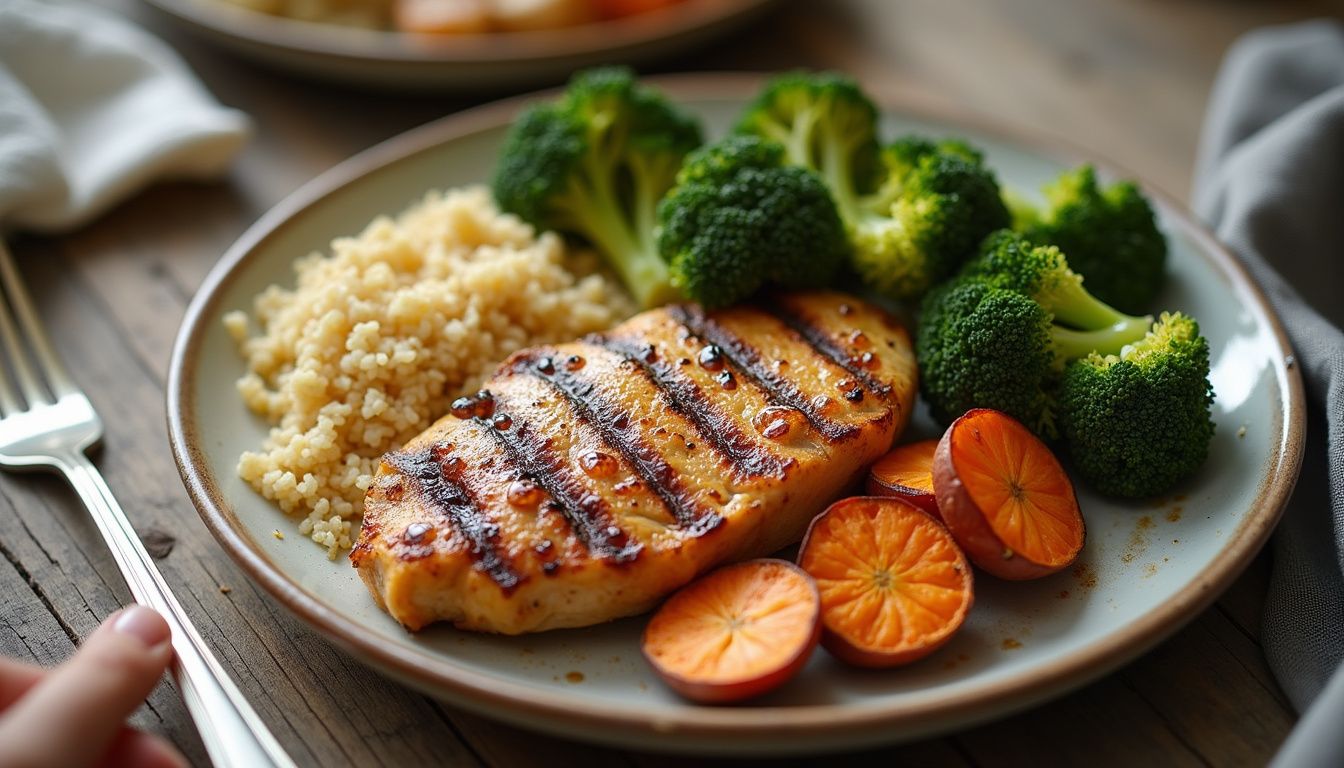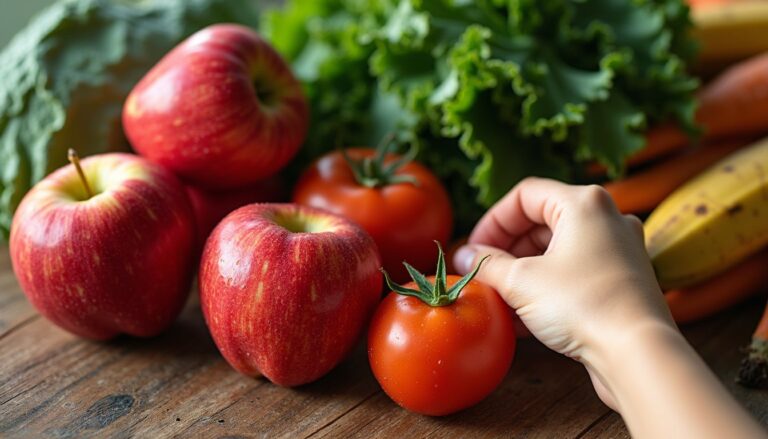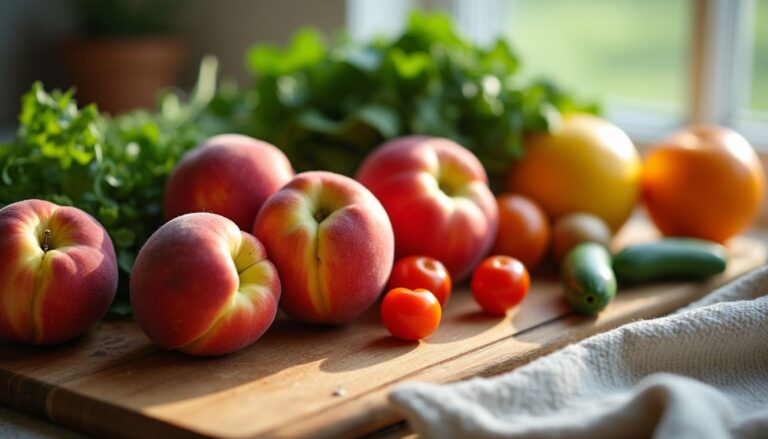7-Day Gym Diet Plan For Muscle Gain: Bodybuilding Meal Plan To Fuel Your Workouts
Our Nutrition Assistant AI Suite will transform your body. You will lose fat, get toned, and build muscle. Gain confidence and optimal health.
Training hard without seeing real changes can feel frustrating. The missing piece is often the food on your plate. A smart meal plan for muscle gain gives your body the raw materials to build, repair, and recover.
Research shows that balanced meals with enough protein, carbohydrates, and healthy fats help you grow muscle and bounce back faster after workouts. This guide walks you through a clear 7-day structure, food picks, and practical tips you can start today.
Fuel your sessions, recover well, and see steady progress.
Key Takeaways
- Most lifters grow best with 1.6 to 2.2 grams of protein per kilogram of body weight daily. Some studies show benefits up to 3.1 g/kg for advanced lifters.
- Eating in a caloric surplus, about 15 percent above maintenance, supports steady gains while limiting extra body fat.
- A useful daily split is 30 to 35 percent protein, 55 to 60 percent carbohydrates, and 15 to 20 percent fats to support training and recovery.
- Limit ultra-processed foods, added sugars, alcohol, and deep-fried items. These choices can slow recovery and increase health risks.
- Whey protein, about 20 to 25 grams per scoop, and creatine monohydrate are well studied and can help when used with a high-protein bodybuilding meal plan.

Why is Nutrition Important for Muscle Gain?

Your results depend as much on your fork as your barbell. Muscle tissue uses amino acids, which come from protein, to repair and grow after training. A bodybuilding meal plan built on whole foods supports recovery, strength, and consistent progress.
Hitting the right calories gives you energy for hard gym sessions. Keeping alcohol, added sugars, and deep-fried foods low helps your health and your gains. People build more lean mass when calorie and protein intake match activity level, as advised in the Dietary Guidelines for Americans.
Following a simple 7-day structure with clear targets for protein, carbs, and fats helped me recover faster after heavy days. The routine made eating easier and results more predictable.
Nutrition is at least half the battle. With whole grains, lean meats or plant proteins, colorful vegetables, fruit, and solid hydration, you set the stage for real growth.
Key Elements of a Muscle-Building Diet
A muscle-building diet is a plan that balances macronutrients, the big three nutrients that give you energy and building blocks. These are protein, carbohydrates, and fats. Getting the amounts right helps you hit your calorie goal and support muscle growth.
How Much Protein Do You Need for Muscle Growth?
Most lifters do well with 1.6 to 2.2 grams of protein per kilogram of body weight each day. That equals about 0.7 to 1.0 grams per pound. Higher intakes up to 3.1 g/kg can help in short phases for advanced training blocks.
For example, at 150 pounds, aim for 105 to 150 grams per day. The general RDA, 0.36 grams per pound, is not enough if you are trying to build muscle.
Include a quality protein at every meal and snack to drive muscle protein synthesis, which is your body’s process for building new muscle. Practical options per serving include chicken breast about 31 g, whey protein 20 to 25 g per scoop, cottage cheese 20 to 25 g per cup, shrimp about 20 g per 3 ounces, tempeh about 19 g per 100 g, lentils about 18 g per cooked cup, and eggs about 6 g each.
What is a Caloric Surplus and Why Does It Matter?
A caloric surplus means you eat more calories than you burn. For muscle gain, increase your daily calories by roughly 15 percent. If your body weight holds steady at 3,000 calories, target about 3,450 during your bulk.
Weigh yourself three times per week and log your food to find your maintenance level first. Then add calories and track progress.
Your muscles need extra energy to repair, grow, and add new tissue after hard training.
Try to gain about 0.5 to 1 percent of body weight per week. This pace helps you add muscle while limiting extra fat. Recheck calorie needs monthly and adjust based on body weight and gym performance.
How to Balance Carbs, Proteins, and Fats for Muscle Gain?
A balanced macro split gives you energy and recovery. Aim for 30 to 35 percent protein, 55 to 60 percent carbs, and 15 to 20 percent fat. This works for most bulking and cutting phases with small tweaks.
At 3,450 calories, this could look like 259 to 302 grams of protein, 474 to 518 grams of carbohydrates, and 58 to 77 grams of fat. Choose carbs like brown rice, oats, beans, fruit, and sweet potatoes to refill muscle glycogen, your stored workout fuel. Pick fats from olive oil, nuts, seeds, and avocado to support vitamin absorption and hormones.
Once I raised carbs around my training window, my energy stopped crashing halfway through workouts. Build meals around lean protein, whole grains, vegetables, beans, eggs, and some dairy or yogurt for variety.
Best Foods to Include in a Muscle-Building Diet
Choose foods that pack nutrients, support recovery, and fit your taste. Mixing animal and plant options gives you more flexibility day to day.
Which Lean Proteins Are Best for Muscle Growth?
Pick lean proteins that offer essential amino acids, the parts of protein your body uses. Good choices include sirloin steak, lean ground beef, pork tenderloin, chicken breast, turkey, and fish like salmon or tilapia.
Salmon adds omega-3 fats that can lower inflammation, helpful after training. Dairy proteins such as Greek yogurt, cottage cheese, low-fat milk, and hard cheeses give you protein plus calcium for bone health. Whey or casein powders can help you hit protein targets when whole food falls short, as supported by peer-reviewed studies in sports nutrition.
What Are the Best Complex Carbohydrates for Energy?
Slow-digesting carbs fuel tough workouts and help you last longer. Try oatmeal, quinoa, brown rice, whole grain bread, and high-fiber cereals. These also provide minerals like magnesium and iron that support recovery.
Starchy vegetables like sweet potatoes, peas, and corn work well too. Legumes such as black beans and lentils add carbs plus protein. Pair complex carbs with protein after training to refill glycogen and support repair.
Which Healthy Fats Support Muscle Gain?
Healthy fats provide energy and help absorb fat-soluble vitamins like vitamin D. Use olive oil or avocado oil for cooking, and add avocado, nuts, seeds, and full-fat or low-fat dairy based on your calorie needs.
Snack on almonds or peanuts, or add seeds to salads and yogurt for steady fuel. Avoid large high-fat meals right before training because they digest slowly and may upset your stomach.
What Plant-Based Proteins Can Help Build Muscle?
Plant eaters can build muscle with the right mix. Chickpeas, lentils, kidney beans, black beans, pinto beans, tofu, tempeh, and soy milk are strong options. Tempeh offers about 19 grams of protein per 100 grams. Pea protein powder gives about 20 to 25 grams per scoop.
Nuts and seeds such as almonds, walnuts, chia, flax, and sunflower seeds add protein, fiber, and helpful fats. Research links a diverse, fiber-rich diet to healthier gut microbes, which may support muscle health and recovery.
Which Foods Should You Limit or Avoid for Muscle Gain?
The foods you skip matter. Cutting back on certain items can speed up recovery and help you add lean tissue with fewer setbacks.
Why Avoid Processed Foods When Building Muscle?
Ultra-processed foods often pack additives, excess sodium, and refined carbs with few nutrients. High intake links to higher risk of heart disease and weight gain. These foods rarely deliver enough protein or micronutrients for recovery.
Choose simple foods like cooked chicken breast instead of deli slices. Pick whole grain toast over pastries. Swapping these items helps you gain more muscle and less fat.
How Do Sugary Snacks and Drinks Affect Muscle Growth?
Sugary snacks and sweetened drinks add calories without the protein, vitamins, and minerals you need. They spike blood sugar, then drop it, which can leave you tired.
High added sugar intake is linked with greater cardiovascular risk in peer-reviewed research. During my last cutting phase, trading soda for water improved my training focus and helped me hit my body weight goal faster.
Should You Avoid Alcohol While Trying to Gain Muscle?
Alcohol can reduce muscle protein synthesis, the process that builds muscle after lifting. It may also lower testosterone and raise cortisol, which can slow recovery. Studies report that regular drinking can reduce strength and training quality.
If you choose to drink, keep it light and away from hard training windows. Many lifters find progress improves when they limit alcohol to special occasions. If you have a health condition or use medications, speak with your clinician about safe limits.
What Are the Downsides of Deep-Fried Foods for Muscle Building?
Deep-fried foods like fries, chicken strips, and cheese curds can increase inflammation and slow recovery. Research also links frequent fried food intake with changes in gut bacteria that may harm digestion and nutrient absorption.
These foods are energy dense and easy to overeat. Bake, grill, air-fry, or roast for similar flavor with less oil and better results.
Supplements that Help Support Muscle Growth
Supplements can fill gaps, but they work best on top of a solid diet. Focus on a strong base first, then add only what helps your goals.
When Should You Use Protein Powders?
Use protein powders if you struggle to hit daily targets with food alone. Many athletes aim for about 0.7 to 1.0 grams per pound of body weight each day. A standard scoop of whey gives about 20 to 25 grams of complete protein.
Shakes are useful after lifting or on busy days. They supplement your diet, they do not replace meals. Whole foods like chicken, eggs, yogurt, tofu, and beans should still anchor your plan.
How Does Creatine Support Muscle Gain?
Creatine monohydrate increases your muscle energy system, called phosphocreatine. That boost helps you squeeze out more reps and create a stronger training stimulus. Reviews show consistent strength and mass gains with well dosed creatine for people who lift.
Creatine is affordable, well studied, and safe for healthy adults when used as directed. Combine it with solid training and protein-rich meals for best results.
What Are BCAAs and How Do They Help?
Branched-chain amino acids, or BCAAs, include leucine, isoleucine, and valine. They help reduce muscle protein breakdown and may decrease soreness. Benefits are smaller if your daily protein intake is already high from complete protein sources.
If your protein is low, BCAAs can help. If your protein intake is on target, a full serving of whey, casein, or a mixed meal gives you a wider range of amino acids and usually works better.
Why Are Omega-3 Fatty Acids Beneficial for Muscle Growth?
Omega-3 fats, found in fatty fish, walnuts, and flaxseed oil, can lower inflammation and support muscle recovery. Some studies suggest they may improve muscle function in active people, especially when paired with training and adequate protein.
Include fish 2 times per week or discuss a fish oil supplement with your clinician if you do not eat fish.
How to Create a 7-Day Gym Diet Plan for Muscle Gain
You can build a simple, repeatable 7-day plan with a few steps. Start with calories and macros, then slot in meals you enjoy and can prep on a busy week.
How to Calculate Your Caloric Needs and Macronutrient Ratios?
Track everything you eat for two weeks and watch body weight trends. The calorie level where weight is stable is your maintenance number. To build muscle, add about 15 percent.
For example, if you maintain at 3,000 calories, set your goal to about 3,450. Divide those calories into macros. A common split at 3,450 calories is 259 to 302 grams of protein, 474 to 518 grams of carbs, and 58 to 77 grams of fat.
Target gains of 0.5 to 1 percent body weight per week. Adjust monthly based on weight change, gym performance, energy, and hunger. Use simple add-ons like olive oil, nut butter, and whole grains to hit your numbers.
What Are Nutrient-Dense Meals and Snacks for Muscle Gain?
Nutrient-dense foods give you many nutrients per calorie. Build meals around lean proteins, complex carbs, healthy fats, vegetables, and fruit.
- Breakfast: oatmeal cooked in milk with berries and peanut butter, or egg muffins with peppers and spinach.
- Lunch: grilled chicken sandwich on whole grain bread with cucumber and a side of beans.
- Snacks: Greek yogurt with fruit, a shake made with whey or pea protein, or hummus with whole grain crackers.
- Dinner: lentil and vegetable soup with a baked potato and olive oil, or salmon with quinoa and broccoli.
Meal prep makes this easier. During my meet prep in 2023, cooking proteins and grains in batches helped me hit targets without stress.
Sample 7-Day Meal Plan for Muscle Gain
Use this 7-day outline as a starting point. Adjust portions to match your calorie and macro goals.
What Does a High-Protein Breakfast Look Like on Day 1?
Blend a shake with Greek yogurt, milk, and berries. Pair it with whole grain toast and scrambled eggs. You start the day with 35 to 45 grams of protein plus fiber for steady energy.
High-protein breakfasts support muscle protein synthesis after your overnight fast. Early protein timing is linked with better recovery and growth in sports nutrition research.
How to Plan a Carbohydrate-Rich Pre-Workout Meal on Day 2?
About 60 to 90 minutes before training, aim for 50 to 70 grams of carbs with a little protein. Try oatmeal with banana and a scoop of whey, or whole grain toast with honey and low-fat yogurt.
Keep fats and very high fiber lower before lifting to avoid stomach discomfort. This timing helps top off glycogen so you can push harder.
How to Incorporate Plant-Based Proteins and High-Fiber Veggies on Day 3?
Build meals with lentils, beans, tofu, or tempeh. Add high-fiber vegetables like broccoli, spinach, peppers, and mushrooms. These foods supply protein, iron, potassium, and magnesium that support training.
Example day: a veggie scramble with black beans for breakfast, a quinoa bowl with tempeh and broccoli for lunch, and a hearty lentil stew over brown rice for dinner. Many lifters find this pattern keeps them full and supports steady strength gains.
Which Healthy Fats Provide Sustained Energy on Day 4?
Include olive oil, avocado, nuts, seeds, and dairy to reach your fat target. These fats help you meet calories, support hormone health, and keep you satisfied between meals.
Try avocado toast with eggs in the morning, olive oil on a grain bowl at lunch, and salmon with roasted potatoes at dinner. Avoid very high-fat meals right before training to keep digestion smooth.
How to Combine Lean Meats, Whole Grains, and Green Vegetables on Day 5?
Pair grilled chicken with brown rice and sautéed spinach for lunch. Bake salmon for dinner and serve it with quinoa and steamed kale. Each meal includes lean protein, slow carbs, and fiber-rich greens.
Add a Greek yogurt snack topped with pumpkin seeds to cover minerals like zinc and magnesium. This pattern supports steady energy and recovery after intense days.
How to Replenish Glycogen with Complex Carbs and Proteins on Day 6?
After hard sessions, focus on complex carbs and protein. Combine oatmeal, sweet potatoes, or brown rice with chicken, tofu, or tempeh. This helps refill glycogen and repair muscle tissue.
Example plate: brown rice with black beans, broccoli, a drizzle of olive oil, and grilled salmon. Whole foods like these keep energy stable and support the next day’s training.
What Are Balanced Meals Focused on Recovery and Hydration on Day 7?
Recovery day meals should rehydrate and provide electrolytes. Include water-rich foods like oranges, watermelon, cucumbers, spinach, and potatoes. Keep protein steady to continue repair.
Build plates with lean protein, whole grains, and colorful produce. Use olive oil or avocado for healthy fats. Limit high-sodium processed foods, and drink water regularly across the day.
What Are the Benefits of Following a 7-Day Muscle-Building Diet Plan?
A structured plan reduces guesswork and helps you stay consistent. You get the fuel you need for training, plus the nutrients your body uses to rebuild stronger tissue.
How Does This Plan Increase Muscle Mass and Strength?
Enough daily protein paired with progressive lifting drives muscle hypertrophy, which means growth in muscle size. Carbs fuel hard sessions, fats support hormones, and total calories push you into a building mode.
Sticking to the plan day after day helps you add reps, increase load, and recover faster. I noticed clear strength jumps once my meals aligned with my training blocks.
How Does It Improve Workout Performance and Recovery?
Complex carbs top off glycogen so you can train longer and with higher intensity. Protein after lifting repairs muscle fibers, which improves recovery and next-day readiness.
Fluids and electrolytes reduce cramps and fatigue. Eating a protein plus carb meal within about 30 minutes after training can speed recovery for many people.
How Does It Help Maintain Balanced Energy Levels?
Balanced meals stabilize blood sugar and help prevent energy crashes. Fiber helps you feel full between meals, and protein steadies appetite hormones so you focus better.
Water-rich fruits and vegetables support hydration. Skipping alcohol helps because alcohol dehydrates and can disturb sleep, which slows recovery.
What Challenges Might You Face and How Can You Overcome Them?
New routines take time. Planning helps you avoid missed meals and last-minute takeout that does not fit your goals.
How to Manage Meal Prep and Time Constraints?
Batch cook proteins like chicken, tofu, or lentils and store in portions. Cook grains in bulk, then add frozen or pre-cut vegetables for fast meals.
Set a weekly prep block, even one hour. Keep quick snacks ready, such as yogurt with berries, cheese sticks, trail mix, or boiled eggs. A simple plan reduces stress and keeps you on track after long days.
How to Adjust to a Caloric Surplus Diet?
Increase calories gradually over a week. Add a small portion of rice or oats here, a drizzle of olive oil there, or an extra glass of milk at night.
Weigh in weekly under similar conditions and track how you feel. If you gain 0.5 to 1 pound per week, you are likely in a good range for muscle growth with limited fat gain.
What Should Beginners Consider When Starting a Muscle-Building Diet?
Start simple and be patient. Consistency beats perfection. Small changes add up over weeks and months.
How to Make Gradual Dietary Adjustments?
Make one or two changes at a time. Add an extra serving of protein, swap refined grains for whole grains, or include a vegetable at each meal.
Increase total calories by about 15 percent if your goal is to gain. Track your intake and your body weight once per week to guide adjustments. Replacing candy with fruit made cravings easier for me and improved my training energy within two weeks.
When Should You Consult a Registered Dietitian or Nutritionist?
If you are unsure about calories, macros, or food choices for your body and goals, a registered dietitian can help. A dietitian can tailor your plan to your activity level, food preferences, and any health condition.
Seek professional help if you have digestive issues, food allergies, diabetes, kidney disease, or struggle to meet your targets. Expert guidance can prevent trial-and-error and protect your health.
Frequently Asked Questions
These quick answers clear up common concerns and help you apply the plan with confidence.
Can You Build Muscle in Just 7 Days?
Visible muscle growth in a week is uncommon. Muscle changes are gradual and require training with progressive overload and consistent nutrition. Early changes are often water and glycogen, not new muscle tissue.
Stick with the plan for several weeks. Most people see measurable strength and size changes in 4 to 8 weeks.
What is the Best Macronutrient Ratio for Muscle Gain?
A helpful starting point is 30 to 35 percent protein, 55 to 60 percent carbohydrates, and 15 to 20 percent fats. Adjust inside these ranges based on energy, hunger, and progress.
Choose mostly whole, minimally processed foods. This supports recovery, sleep, and training quality better than a diet heavy in sweets and alcohol.
Should Rest Days Have Different Meals?
Keep protein consistent on rest days. Your body is still repairing and growing. Carbs can come down slightly if you prefer, but many lifters feel better keeping meals similar for easier planning and steady recovery.
Conclusion
A simple 7-day gym diet plan can power your training and support muscle gain. Build meals around protein, complex carbs, and healthy fats. Keep alcohol, added sugar, and deep-fried foods low to recover faster and stay healthy.
Track calories and use the macro ranges that fit your body and goals. Meal prep once or twice a week so your plan survives busy days. For a custom approach, work with a registered dietitian who can align your plan with your training, preferences, and health needs.
This information is educational and not a substitute for medical advice. If you have a medical condition, talk with your healthcare provider before making major diet changes or starting supplements.
FAQs
1. What is a 7-day gym diet plan for muscle gain and how does it help bodybuilding?
A 7-day gym diet plan for muscle gain uses only high-quality sources to guide food choices that support strength training. This meal plan provides the right balance of protein, carbohydrates, and healthy fats to fuel workouts and promote muscle growth.
2. How do I know if the bodybuilding meal plan uses only high-quality sources?
Reputable plans reference scientific studies or expert guidelines from trusted organizations in nutrition and sports science. These references ensure accuracy so you can trust the information supports your fitness goals.
3. Can following a structured meal plan improve my workout results?
Yes; evidence shows that athletes who follow structured diets based on high-quality sources often see better gains in strength and size compared to those without a set eating pattern.
4. Why should I choose a bodybuilding meal plan with credible references over generic advice?
Plans using only high-quality sources rely on proven data rather than opinions or trends. This approach reduces risk of misinformation, helping you make safe choices that align with your health needs while supporting effective muscle building strategies.







